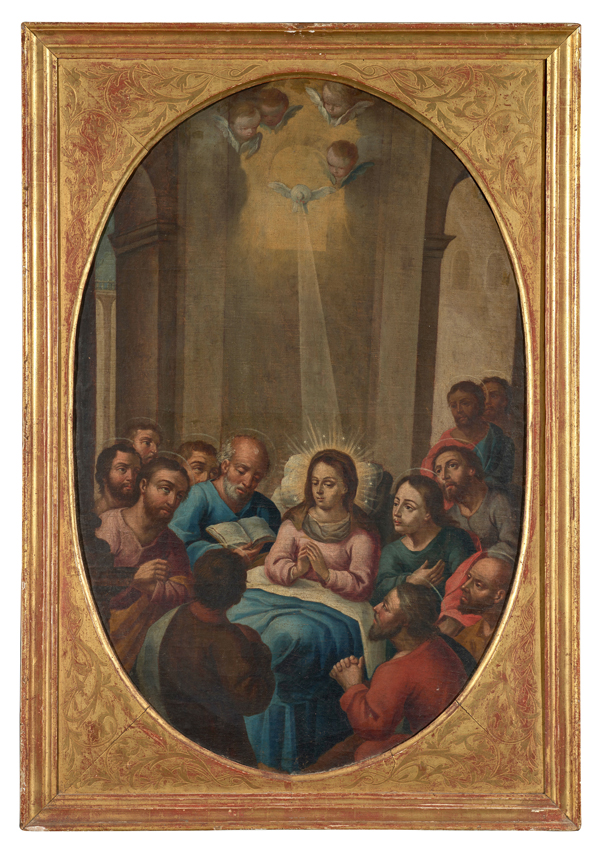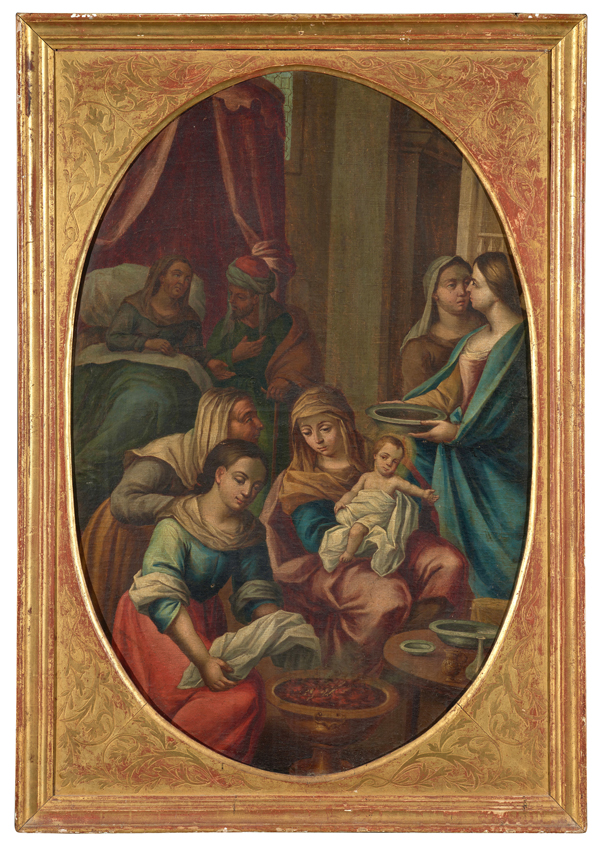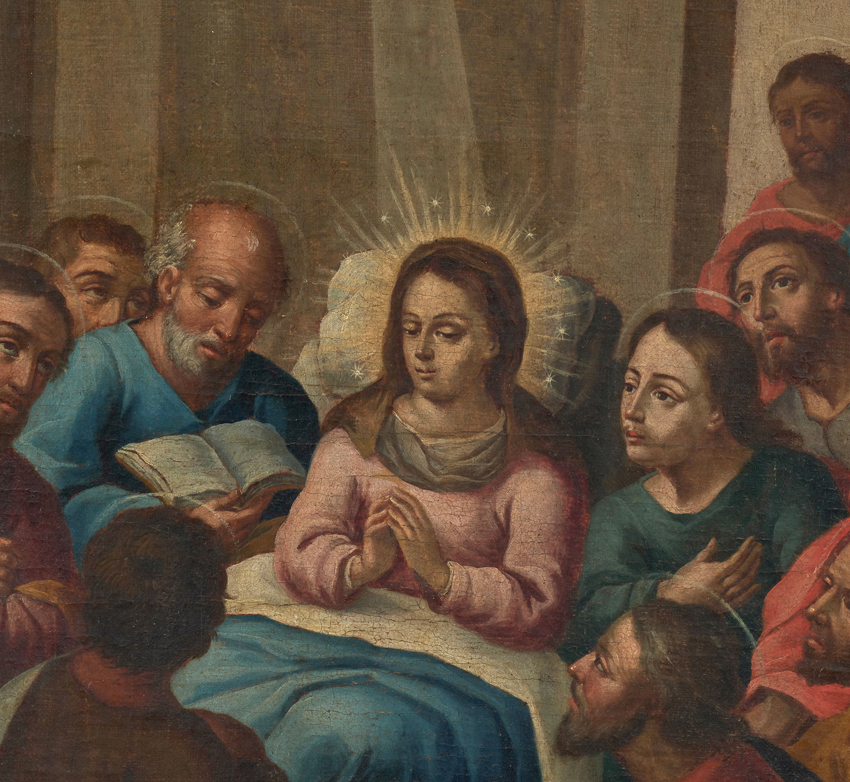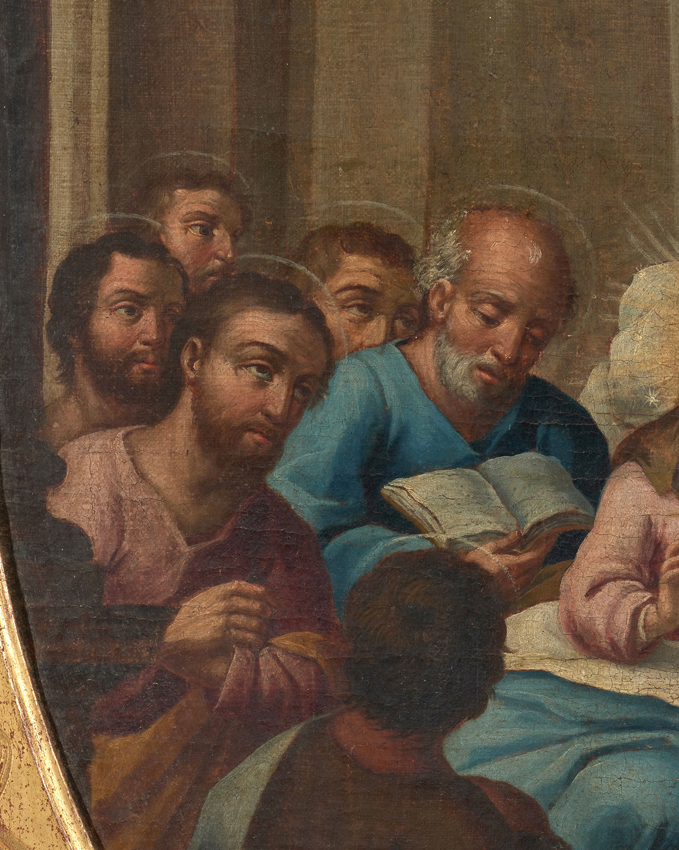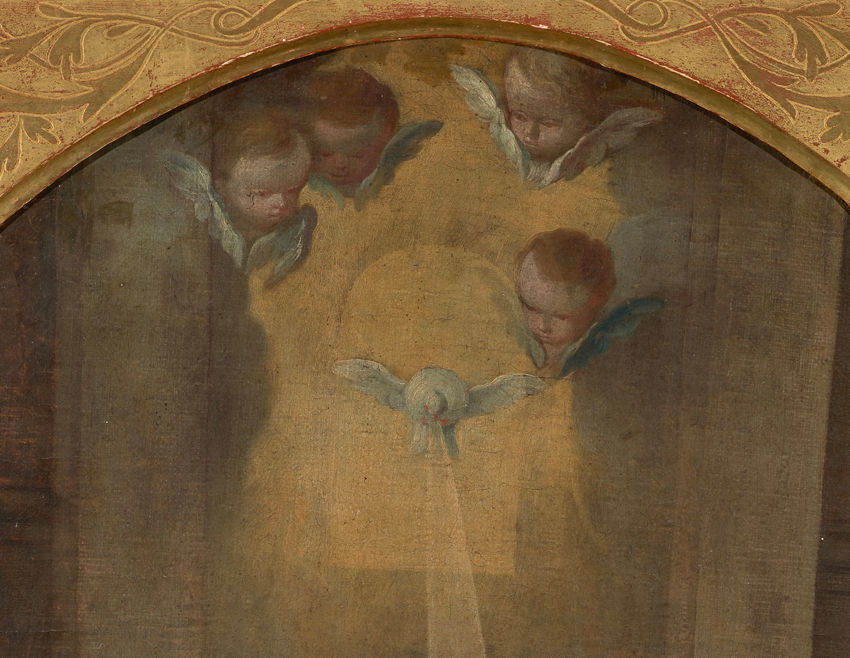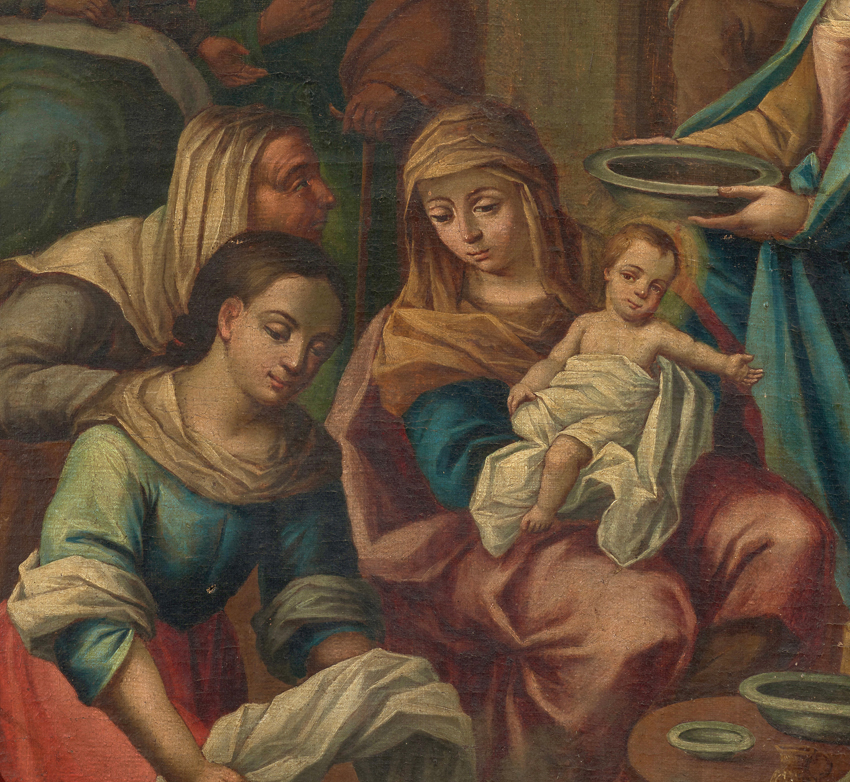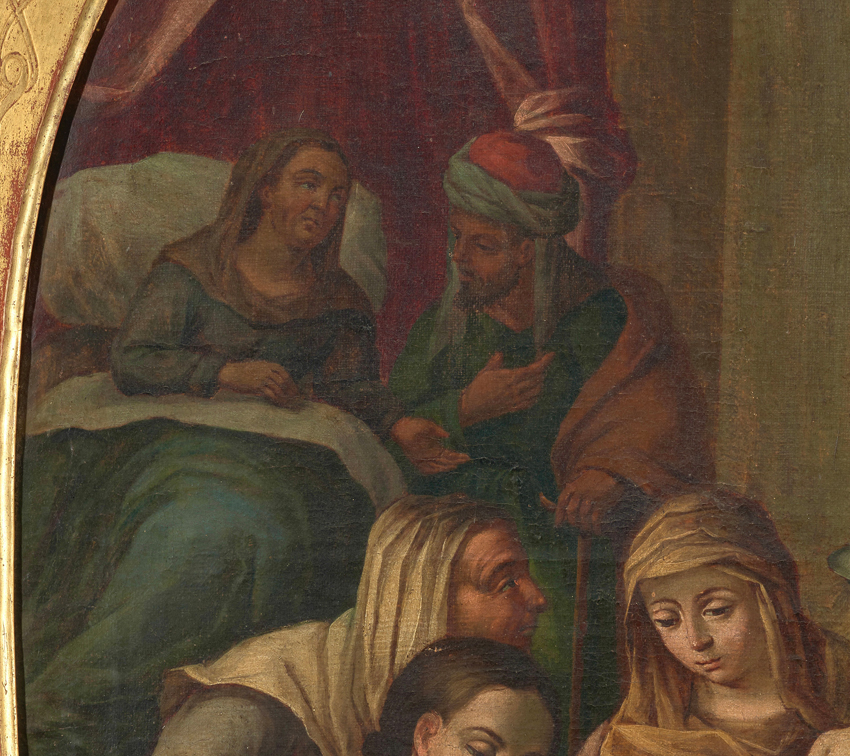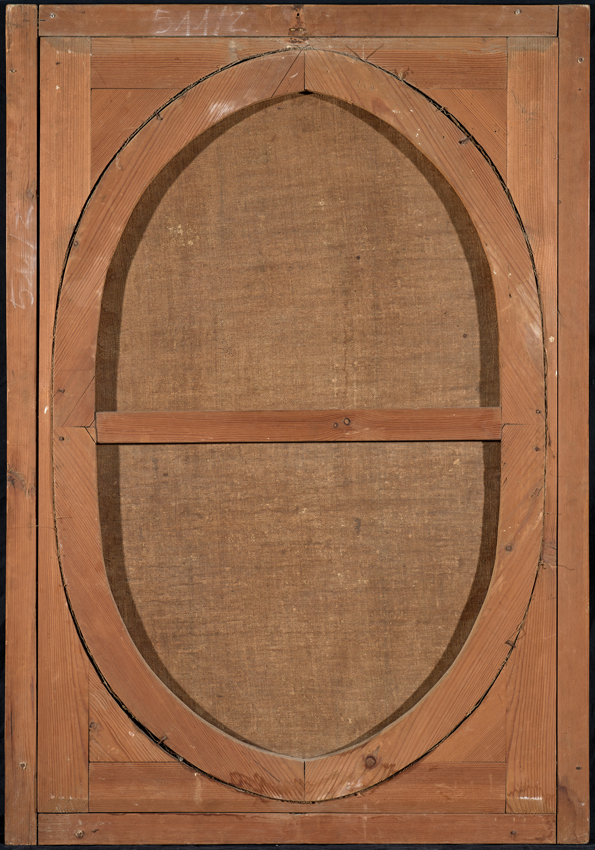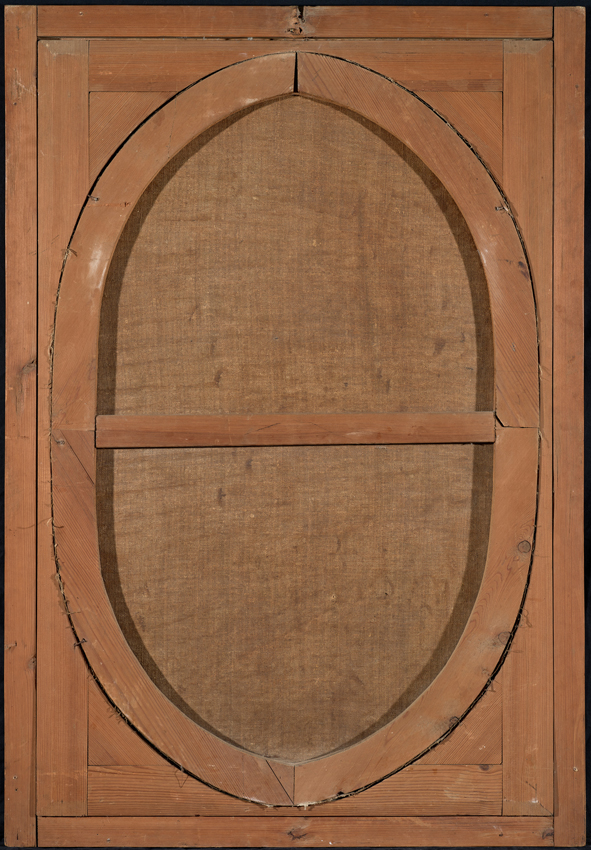40
Juan Pedro Lopez (Viceroyalty of New Granada, Currently Venezuela, 1724 - 1787)
Juan Pedro Lopez (Viceroyalty of New Granada, Currently Venezuela, 1724 - 1787)
“Pentecost” and ‘The birth of St. John the Baptist’.
Pair of oil paintings on canvas.
95,5 x 62,5 cm each.
Magnificent pair of oval oil paintings with two completely different scenes of a religious character: “Pentecost” and “The birth of St. John the Baptist”,
These two paintings, attributable with total certainty to the Venezuelan colonial painter Juan Pedro López (1724-1787), are remarkable for their detailed composition, religious iconography and the remarkable technical quality that characterizes the art from this Caracas workshop.
Master Juan Pedro López was one of the few artists in all of Latin America who made his own frames. These paintings are perfect examples of Juan Pedro López's talent, both in painting and in the creation of frames.
Lopez is recognized for his baroque style, characterized by a balance between dramatization and meticulous detail. Both paintings demonstrate his skill in handling chiaroscuro, creating depth and directing the viewer's gaze to the central elements of the composition. The diagonal lines and soft curves, common in the Baroque tradition, bring dynamism and movement to the scenes. A key aspect that supports the attribution of these works to Juan Pedro López is the presence of their original frames, created in the same workshop as the paintings. The frames, made of carved wood and decorated with baroque motifs gilded in gold leaf, are an integral complement to the pictures within them.
This integral approach, in which painting and frame are conceived as a unit, reflects the practice of 18th century colonial workshops, especially those of the highest prestige such as that of Lopez.
The first painting depicts “Pentecost”, clearly, where the coming of the Holy Spirit to the apostles, gathered around Mary, is commemorated.
This celebration takes place 50 days after Easter, thus ending the Easter season.
On the morning of Pentecost, while the apostles were praying with Mary, the mother of Jesus, the Holy Spirit descended upon them.
This event marks the birth of the Church and with it the spread of faith in Jesus Christ (Acts 2:1-5).
The apostles are depicted in the painting as seated, forming a majestic group dressed in severe robes, surrounding the Virgin Mary, in an attitude of prayer.
As they pray, an attitude reflected in their joined hands and in their ecstatic faces that look at Mary or at the Spirit that descends upon them, their serene faces are “listening with attention and devotion”.
To complete the scene of the Pentecost, “the tongues like flames resting on them” are missing, but in our opinion this could be “a snapshot of the first moment” when “the Dove bursts with a roar”.
We can count 12 apostles in the scene. It should be remembered that, according to Christian beliefs, after the suicide of Judas Iscariot, the 11 remaining apostles gathered and chose Matthias to complete the number of 12 sent to the 12 tribes of Israel.
The figures are set in typical Renaissance architecture.
The second scene, as its title indicates, depicts the birth of the Precursor.
In the center are three women cleaning up the newborn. Behind them, two other women are standing and chatting, one of them carrying a basin of water.
On the left, a bed, with a canopy, almost plunged in darkness, where we see an old Zechariah, with a cane, the father of the child, who “had remained mute for having doubted the word of the angel”, and the woman in labor, Elizabeth, lying down, plunged in semi-darkness. In the background is architecture without a landscape.
With great chromatism, the Caracas artist contrasts light and shadow, colors, dim and muted and more vibrant, with the aim of depicting an intimate vision.
In this painting, white light concentrates on the baby and radiates to the women around him, while the rest of the composition is more somber.
These works stand out for their interior setting, very much to the taste of naturalism, in such a way that they are two scenes with an everyday flavor.
Juan Pedro López, a central figure in the development of Baroque art in Venezuela, was a painter and teacher, responsible for the training of important artists in his workshop in Caracas, and who exerted a significant influence on religious painting in the region during the 18th century. His influence extended beyond his time, leaving an enduring legacy in the religious art of the region.
López's work is essential to understanding the development of Novo-Hispanic art in Venezuela. His paintings, imbued with a deep religiosity and outstanding technical mastery, are a testimony to the baroque aesthetic that predominated in the Spanish colonies. Today, many of his paintings are in important collections and museums, preserved as part of Venezuelan cultural heritage.
From the 1960s onwards, through the work of critics of the stature of Alfredo Boulton and Carlos Federico Duarte, López was rescued and revalued as a central figure in the development of Venezuelan art in New Granada, and he is considered one of the most important artists of the Viceroyalty of New Granada in Venezuela. As a painter, sculptor and gilder he illuminated the sombre art of his time with the light and grace of Hispano-American Rococo, the style to which the master is related.
Much of Juan Pedro López's work was of a religious nature, in keeping with the tastes and fashions of the time. His iconography was far removed from the dramatic and tragic aspects customary at the time, and he focused on the production of humorous and cheerful images that were more appealing to the parishioners.
One of the first important paintings with which this master ventured into pictorial art was the commission in 1752 for sixteen paintings grouped under the title "History of the Life of the Virgin" at the request of the confraternity of Nuestra Señora de Guía in the church of San Mauricio, to be displayed on the main altar. The importance of this group of paintings is due to the fact that they bring together "all the formulas, scenes and typology of the characters to be found throughout his oeuvre" (Duarte Carlos).
In addition to paintings, Juan Pedro López also produced sculptural pieces, and at the same time as both practices, he received requests for the restoration of paintings and sculptures, retouching, modifications, additions, among others. As a curious fact, another activity carried out by López was the painting of candles that were used in ecclesiastical rituals, which was very common at that time.
The majority of his output consisted of commissions from churches, brotherhoods, convents, and private individuals, rather than stemming from personal inspiration.
Reference bibliography:
- Boulton, Alfredo. Historia de la Pintura en Venezuela. Ediciones Ariel, 1972.
- Carlos F. Duarte. Juan Pedro López: Maestro de Pintor, Escultor y Dorador, 1724-1787. Galería de Arte Nacional, 1996.
Juan Pedro Lopez (Viceroyalty of New Granada, Currently Venezuela, 1724 - 1787)
“Pentecost” and ‘The birth of St. John the Baptist’.
Pair of oil paintings on canvas.
95,5 x 62,5 cm each.
Magnificent pair of oval oil paintings with two completely different scenes of a religious character: “Pentecost” and “The birth of St. John the Baptist”,
These two paintings, attributable with total certainty to the Venezuelan colonial painter Juan Pedro López (1724-1787), are remarkable for their detailed composition, religious iconography and the remarkable technical quality that characterizes the art from this Caracas workshop.
Master Juan Pedro López was one of the few artists in all of Latin America who made his own frames. These paintings are perfect examples of Juan Pedro López's talent, both in painting and in the creation of frames.
Lopez is recognized for his baroque style, characterized by a balance between dramatization and meticulous detail. Both paintings demonstrate his skill in handling chiaroscuro, creating depth and directing the viewer's gaze to the central elements of the composition. The diagonal lines and soft curves, common in the Baroque tradition, bring dynamism and movement to the scenes. A key aspect that supports the attribution of these works to Juan Pedro López is the presence of their original frames, created in the same workshop as the paintings. The frames, made of carved wood and decorated with baroque motifs gilded in gold leaf, are an integral complement to the pictures within them.
This integral approach, in which painting and frame are conceived as a unit, reflects the practice of 18th century colonial workshops, especially those of the highest prestige such as that of Lopez.
The first painting depicts “Pentecost”, clearly, where the coming of the Holy Spirit to the apostles, gathered around Mary, is commemorated.
This celebration takes place 50 days after Easter, thus ending the Easter season.
On the morning of Pentecost, while the apostles were praying with Mary, the mother of Jesus, the Holy Spirit descended upon them.
This event marks the birth of the Church and with it the spread of faith in Jesus Christ (Acts 2:1-5).
The apostles are depicted in the painting as seated, forming a majestic group dressed in severe robes, surrounding the Virgin Mary, in an attitude of prayer.
As they pray, an attitude reflected in their joined hands and in their ecstatic faces that look at Mary or at the Spirit that descends upon them, their serene faces are “listening with attention and devotion”.
To complete the scene of the Pentecost, “the tongues like flames resting on them” are missing, but in our opinion this could be “a snapshot of the first moment” when “the Dove bursts with a roar”.
We can count 12 apostles in the scene. It should be remembered that, according to Christian beliefs, after the suicide of Judas Iscariot, the 11 remaining apostles gathered and chose Matthias to complete the number of 12 sent to the 12 tribes of Israel.
The figures are set in typical Renaissance architecture.
The second scene, as its title indicates, depicts the birth of the Precursor.
In the center are three women cleaning up the newborn. Behind them, two other women are standing and chatting, one of them carrying a basin of water.
On the left, a bed, with a canopy, almost plunged in darkness, where we see an old Zechariah, with a cane, the father of the child, who “had remained mute for having doubted the word of the angel”, and the woman in labor, Elizabeth, lying down, plunged in semi-darkness. In the background is architecture without a landscape.
With great chromatism, the Caracas artist contrasts light and shadow, colors, dim and muted and more vibrant, with the aim of depicting an intimate vision.
In this painting, white light concentrates on the baby and radiates to the women around him, while the rest of the composition is more somber.
These works stand out for their interior setting, very much to the taste of naturalism, in such a way that they are two scenes with an everyday flavor.
Juan Pedro López, a central figure in the development of Baroque art in Venezuela, was a painter and teacher, responsible for the training of important artists in his workshop in Caracas, and who exerted a significant influence on religious painting in the region during the 18th century. His influence extended beyond his time, leaving an enduring legacy in the religious art of the region.
López's work is essential to understanding the development of Novo-Hispanic art in Venezuela. His paintings, imbued with a deep religiosity and outstanding technical mastery, are a testimony to the baroque aesthetic that predominated in the Spanish colonies. Today, many of his paintings are in important collections and museums, preserved as part of Venezuelan cultural heritage.
From the 1960s onwards, through the work of critics of the stature of Alfredo Boulton and Carlos Federico Duarte, López was rescued and revalued as a central figure in the development of Venezuelan art in New Granada, and he is considered one of the most important artists of the Viceroyalty of New Granada in Venezuela. As a painter, sculptor and gilder he illuminated the sombre art of his time with the light and grace of Hispano-American Rococo, the style to which the master is related.
Much of Juan Pedro López's work was of a religious nature, in keeping with the tastes and fashions of the time. His iconography was far removed from the dramatic and tragic aspects customary at the time, and he focused on the production of humorous and cheerful images that were more appealing to the parishioners.
One of the first important paintings with which this master ventured into pictorial art was the commission in 1752 for sixteen paintings grouped under the title "History of the Life of the Virgin" at the request of the confraternity of Nuestra Señora de Guía in the church of San Mauricio, to be displayed on the main altar. The importance of this group of paintings is due to the fact that they bring together "all the formulas, scenes and typology of the characters to be found throughout his oeuvre" (Duarte Carlos).
In addition to paintings, Juan Pedro López also produced sculptural pieces, and at the same time as both practices, he received requests for the restoration of paintings and sculptures, retouching, modifications, additions, among others. As a curious fact, another activity carried out by López was the painting of candles that were used in ecclesiastical rituals, which was very common at that time.
The majority of his output consisted of commissions from churches, brotherhoods, convents, and private individuals, rather than stemming from personal inspiration.
Reference bibliography:
- Boulton, Alfredo. Historia de la Pintura en Venezuela. Ediciones Ariel, 1972.
- Carlos F. Duarte. Juan Pedro López: Maestro de Pintor, Escultor y Dorador, 1724-1787. Galería de Arte Nacional, 1996.
Latin America, cultures in alchemy
Sale Date(s)
Venue Address
General delivery information available from the auctioneer
The purchase price includes the delivery of the lots in the venue of the auction. Transporting to other destinations is at the own risk of the client. The customer must contact "LST", to give the corresponding instructions for such transporting. "LST" is not responsible for the packaging or any accident incurred during transportation.
Important Information
We remind our customers that, as indicated in our conditions of sale, for works over 100 years old, an export license from the Spanish Ministry of Culture is required.
This procedure is carried out by us free of charge for our clients.
The Spanish administration delivers it free of charge for EU members, but applies fees for non-EU buyers. Please contact us for further information and details.
Terms & Conditions
CONDITIONS OF THE AUCTION:
I. REGISTRATION. To bid in the room customers must register at the beginning, filling out a form and picking a number that will identify them during the auction. Customers may be required to register in bank references or other guarantee system and if they do not prove the solvency "LST" will not accept bids and award the auction.
II. WRITTEN BIDS. "LST" will accept written bids, which will be formalized in the form provided by the room until the day before the auction. In such auctions, the room will bid in name of the client until the maximum stated in the offer and always at the lowest possible price. If there are two or more bids for the same amount, the one placed first will have the priority. Written bids received in advance, will have priority on the day of the auction.
III. TELEPHONE BIDS. "LST" will allow telephone bids, if interested people contact "LST" days before the auction providing personal data, ID card and the phone number which will be used by the staff of "LST" to call at the time of the auction. The buyer, within all the legal rights is making an offer for the asking price, when applies for telephone bid. "LST" will not take responsibility for any technical defects beyond its control, which may prevent to contact successfully the bidder during the auction.
IV. AUCTIONEER. The auction will be conducted by an auctioneer, director of the auction will be judge and arbitrator of it with full authority in its development, will award the lots to the highest bidder and is able to settle any controversy concerning lots sale, reject bids, divide lots or group them and remover objects from the room. Will be able to, if it is deemed suitable, not accept bids on the auction. His decision will be unappealable.
V. SALE OF LOTS. The lots are awarded to the highest bidder. Once the auctioneer blows the hammer, the buyer becomes responsible of the lot purchased, exempting "LST" of liability to for any damage and / or accidents that may occur. No refunds of lots.
VI. STARTING PRICE. The amount shown in the catalogue as the starting price for each lot will be, as a rule, the minimum selling price, except for exceptional cases where a reservation may be agreed upon with the seller or it set discretionary by the room.
VII. SCALE OF BIDS. The bids are set according to the following scale:
From 50.-€ to 200.-€…………………………………………..at 10.-€
From 200.-€ to 500.-€…………………………………… …25 in 25.-€
From 500.-€ to 1.000.-€………………………………..…..….50 in 50.-€
From 1.000.-€ to 2.000.-€………………………………..…100 in 100.-€
From 2.000.-€ to 5.000.-€……………………………….….250 in 250.-€
From 5.000.-€ to 10.000.-€…………………………………500 in 500.-€
From 10.000.-€ to 20.000.-€……………………………1.000 in 1.000.-€
From 20.000.-€ to 50.000.-€……………………………2.500 in 2.500.-€
From 50.000.-€ to 100.000.-€…………………………..5.000 in 5.000.-€
From 100.000.-€ to 100.000.-€………………………10.000 in 10.000.-€
From 200.000.-€ to 200.000.-€………………………25.000 in 25.000.-€
From 500.000.-€ to 500.000.-€………………………50.000 in 50.000.-€
VIII. RIGHT OF ADMISION. "LST" reserves the right to admission to the auction room and to reject, at its judgment, any purchase order, from clients whose solvency is not duly proved as well as not to sale auctions.
IX. SALE PRICES. The successful bidder of one or more lots must pay "LST" the final sale price achieves at auction, plus the 24,5 % plus 21% VAT on the commission, at total 29,64 % on Hammer Price.
X. CATALOG DATA. The catalogue data are obtained in order to careful research and advice, however, any responsibility is afforded about its accuracy. The lots will be auctioned in the state in which they are, not accepting any claims in restorations, breakage, damage, imperfections and, even description or numbering mistakes in the catalogue, in case of it, being the burden of the buyers to make sure before the auction that the description matches with their personal opinion about respective lot. The exhibition of the lots is intended to allow a perfect review and study of them.
XI. PAYMENT AND REMOVAL OF LOTS. Payment and removal of the lots will be held no later than five days following the auction. After this period expire without having the buyer removed the lot or lots purchases, it will accrue an expense of custody of 6 euros per day on each lot.
15 days after the auction without having the buyer paid and removes the sold lots, "LST" will inform the seller and there will begin judicial proceeding in order to obtain payment. The delay in payment by the purchaser of his/her sold lots will carry an interest increase at a rate of 1,5% per month.
XII. DELIVERY OF LOTS. The purchase price includes the delivery of the lots in the venue of the auction. Transporting to other destinations is at the own risk of the client. The customer must contact "LST", to give the corresponding instructions for such transporting. "LST" is not responsible for the packaging or any accident incurred during transportation.
XIII. RIGHT OF FIRT REFUSAL AND REPURCHASE. "LST" in order to article 38 of "Ley 16/1985 de 25 Junio del Patrimonio Histórico Español" (BOE. 155 June 29, 1985), will notify in advance to the Ministry of Culture, the content of their catalogues. Concerning the lots subject to the legislation referred to in the preceding paragraph, the Administration may exercise the rights of first refusal and repurchase according to the law. "LST" will watch over the protection of Artistic, Historical and Bibliographical Heritage of Spain. For customers out of European Community, a tax for export is required by the Administration.
XIV. VALUE ADDED TAX (I.V.A). This tax will be accrued on commissions of "LST" for buyers, using the rates prevailing on the date of the auction.
XV. DATA PROTECTION. In order to the "Ley 15/1999 de 13 de Diciembre, de Protección de Datos de Carácter Personal", the client authorize "LST", the inclusion of their data in a customer file, and for the promotion by "LST" of the objects at all times the rights of access, rectification or deletion of personal data by sending the appropriate request to the following address: LA SUITE SUBASTAS, C/ Conde Salvatierra, 8, 08006. Barcelona.
XVI. EXPRESS LEGAL JURISDICTION. These Conditions are governed by and interpreted in accordance with the rules of Spanish law. The mere act of participating in the auction as seller, buyer or bidder, implies acceptance of these Terms and Conditions.
Sales operations are understood to be held at the registered office of "LST", C/ Conde de Salvatierra, 8, 08006. Any dispute shall be taken to the competent courts of Barcelona, expressly waiving any other jurisdiction, in accordance with Article 55 of the "Ley de Enjuiciamiento Civil".



























